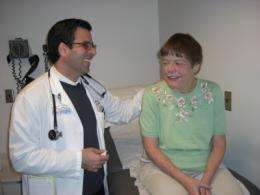'Hybrid' surgery saves UCLA patient from softball-sized aneurysm

Patricia Crawford had literally been tinged blue all her life because her heart couldn’t pump enough oxygenated blood through her body. And that was the least of her worries.
A huge aneurysm the size of a softball in her pulmonary artery was a ticking time bomb. Her heart and liver were failing, too — all adding to the reasons why it was too risky for the 49-year-old to receive the heart-lung transplant she desperately needed to survive. She had been told that she was out of options.
But a team of UCLA adult congenital cardiologists and cardiac surgeons would not give up hope. They performed a unique, high-risk hybrid procedure that combined minimally-invasive method with traditional surgical techniques. They stopped the massive balloon-like aneurysm, replaced a failed heart valve, repaired another valve and also closed a hole in Crawford’s heart.
Now, just a few weeks since the successful Feb. 7 procedure, Crawford is much more active and energetic, and only taking medications for her heart. Most importantly, she no longer needs a heart-lung transplant.
She can’t believe it and has to pinch herself as a reminder that it’s real, Crawford said. She had been told since childhood that she would not survive for more than a few years. Her sister Kathy Crawford said it’s the first time since her sister’s birth that she has a positive prognosis.
Such hybrid surgeries are the start of a major medical trend, said Dr. Jamil Aboulhosn, director of the Ahmanson-UCLA Adult Congenital Heart Disease Center.
“We’re able to do more for high-risk patients like Patti than ever before. We’re performing more creative procedures that blend traditional surgery and minimally-invasive techniques to help patients who previously had few or no options,” said Aboulhosn, who is also an assistant clinical professor of cardiology at the David Geffen School of Medicine at UCLA.
There were major challenges to Crawford’s procedure. Aboulhosn says the 12 centimeter aneurysm threatening her life was one of the largest he’d seen. The presence of severe lung pressure elevation, or pulmonary hypertension, increased the likelihood that the aneurysm could burst at any moment.
Patients like Crawford with pulmonary hypertension are deemed too high risk to undergo open-heart surgery on a heart-lung machine, which takes over work of the heart and lungs in providing circulation and oxygen to the body during the operation.
Aboulhosn and Dr. Hillel Laks, a UCLA professor of cardiothoracic surgery, devised a plan to perform the operation using a novel hybrid intervention to shorten the time needed on the heart-lung machine and thereby give Crawford a better chance of surviving the operation. Hybrid interventions are performed by a surgeon and an interventional cardiologist. The team combines the strengths of traditional heart surgery with less invasive catheter-based interventions to reduce procedure duration, making them less invasive and improving safety.
“By incorporating newer interventions with traditional surgery, we can customize heart operations and that can lead to the best patient outcome,” said Laks, who is also a distinguished UCLA Chancellor’s Professor.
Laks and the operating room team started with traditional surgical methods, placing her on the heart-lung machine and opening the aneurysm by her heart.
Aboulhosn then employed the hybrid intervention by using a new balloon-mounted “melody valve” to replace her failing pulmonary valve and to close the hole in her heart. These two procedures, which normally would take more than an hour to complete surgically, only took 10 minutes thanks to the less-invasive valve-replacement technique.
Laks then used traditional techniques, removed the portion of the artery that had the aneurysm and placed a synthetic tube in its place. He also surgically repaired the tricuspid heart valve.
The use of the hybrid technique with the melody valve shortened the need for the heart-lung machine by more than an hour and the procedure had no complications. Crawford’s circulating oxygen saturation improved from 72 percent immediately before the surgery to 97 percent immediately afterwards, meaning her tissues were finally receiving adequate oxygen, giving her more energy. Her complexion and skin are also now pink and healthy.
“I’m able to do more every day without having to rest, like making a bed, walking down the driveway, packing a suitcase and preparing food,” Crawford said. “Before the operation I would not have dreamed of making my own bed and I would have needed to rest for hours afterwards. It’s been many years since I’ve been able to do anywhere near this level of activity.”



















